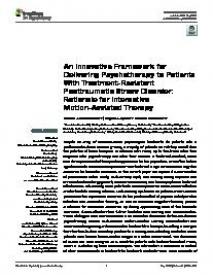An innovative framework for delivering psychotherapy to patients with treatment-resistant posttraumatic stress disorder : Rationale for interactive motion-assisted therapy
Despite an array of evidence-based psychological treatments for patients with a posttraumatic stress disorder (PTSD), a majority of patients do not fully benefit from the potential of these therapies. In veterans with PTSD, up to two-thirds retain their diagnosis after psychotherapy and often their disorder is treatment-resistant, which calls for improvement of therapeutic approaches for this population. One of the factors hypothesized to underlie low response in PTSD treatment is high behavioral and cognitive avoidance to traumatic reminders.
In the current paper we explore if a combination of personalized virtual reality, multi-sensory input, and walking during exposure can enhance treatment engagement, overcome avoidance, and thereby optimize treatment effectiveness. Virtual reality holds potential to increase presence and in-session attention and to facilitate memory retrieval. Multi-sensory input such as pictures and music can personalize this experience.
Evidence for the positive effect of physical activity on fear extinction and associative thinking, as well as embodied cognition theories, provide a rationale for decreased avoidance by literally approaching cues of the traumatic memories. A dual-attention task further facilitates new learning and reconsolidation. These strategies have been combined in an innovative framework for trauma-focused psychotherapy, named Multi-modular Motion-assisted Memory Desensitization and Reconsolidation (3MDR).
In this innovative treatment the therapeutic setting is changed from the face-to-face sedentary position to a side-by-side activating context in which patients walk toward trauma-related images in a virtual environment. The framework of 3MDR has been designed as a boost for patients with treatment-resistant PTSD, which is illustrated by three case examples. The intervention is discussed in context of other advancements in treatment for treatment-resistant PTSD.
Novel elements of this approach are activation, personalization and empowerment. While developed for veterans with PTSD who do not optimally respond to standardized treatments, this innovative framework holds potential to also be used for other patient populations and earlier stages of treatment for patients with PTSD.
In: Frontiers in Psychiatry, ISSN 1664-0640 | 9 | May | article: 176
https://doi.org/10.3389/fpsyt.2018.00176


